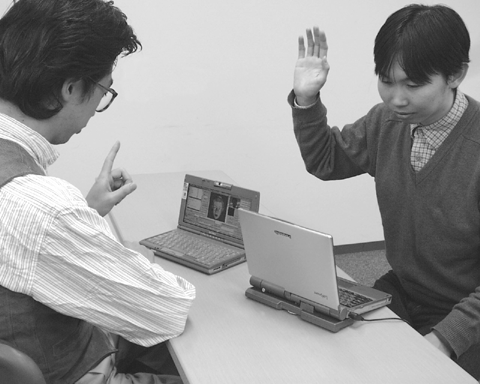
RWC PC Cluster II
Cluster computer developed by TRC
Running the SCore
Cluster System Software
| Junichi Shimada Managing Director, Director of Research Institute Real World Computing Partnership |
After years of struggle, there is light at the end of the tunnel for the RWC Project, as some of our technologies have been implemented in actual applications. Here are some examples.
The Los Alamos National Laboratory demonstrated their accelerator simulation on a cluster computer at the SC98, an international conference on computer technologies. To my surprise and delight, this simulator ran on the SCore Cluster System Software developed by RWC. Also, Alta Technology, an American venture, showed their cluster computer running the SCore Cluster System Software in one of the industry showcases at the same conference.

RWC PC Cluster II
Cluster computer developed by TRC
Running the SCore
Cluster System Software
Of course, we have also several implementations of this technology in Japan. Mitsubishi Electric Corporation has developed a particularly cost-effective, real-time power transmission simulator using the SCore Cluster technology, ready for delivery to a power company.
Within the RWC Project, a protein information analysis system, called PAPIA, has been built on this system. Details of this system are available on the RWC Partnership's web site for anybody to experiment with. During the last year alone, tens of thousands of hits were logged, from dozens of countries around the world. Trainees have been delegated from pharmaceutical companies.


PAPIA System
A protein information analysis system running on RWC PC Cluster II Now available at RWC's web site for experiments
An implementation of the SCore Cluster System Software offers advantages of not only high processing speed but also simultaneous use by many. Yet this is only one milestone in the seamless computing system that the RWC Project is striving to achieve. A seamless computing system is the one that connects various types of PCs on people's desks at offices and other places via a high-speed communication network, yet appears as a single parallel computer, thus enabling tasks that previously would have required a supercomputer to be done from both small and large offices. The RWC Project intends to offer the first such system in the world.
Assume that we're watching a baseball game involving the Giants (the most popular baseball team in Japan) on TV. Young smash hitter Matsui is in the batter's box. The commentator says that his swing this year slightly differs from last year. Wouldn't it be interesting to see the motion image of his swing last year? VideoSpotter, which was developed by the RWC Project and is being commercialized by Media Drive Corporation, is an archive system that makes this possible by allowing us to retrieve motion images in real time in any time frame. Its strength is that it does not require prior segmentation and marking of the video contents - this work is done by a computer which has been trained to learn how. VideoSpotter can also be run on DVD players, which would promote DVD usage. We are trying to make this method the de facto standard for motion image databases.

VideoSpotter
A real-time motion image retrieval system running on a
PC
To be able to support large archives through parallelization
Furthermore, VideoSpotter will be combined with MMPC/net, a PC network which can understand human speech with gestures and hand motions, into an integrated system called CrossMediator.

MMPC/net
PC which understands mixture of speech and gestures
It can
talk with multiple people over a network
There are of course many other technologies developed in RWC Project to be implemented in actual applications, which will be covered later. But as is typical in any national R&D project, implementation comes a long time after the project is completed, and technologies quickly become obsolete in the information technology field. They must therefore be implemented as quickly as possible.
This is because they are governed by de facto standards. Therefore, one of our policies in this project is to make the results attractive to users to encourage them to use the results while the project is still under way. Without doubt, the most useful evaluation of the project results is that from the users, and we thank everyone for all their past and future cooperation.